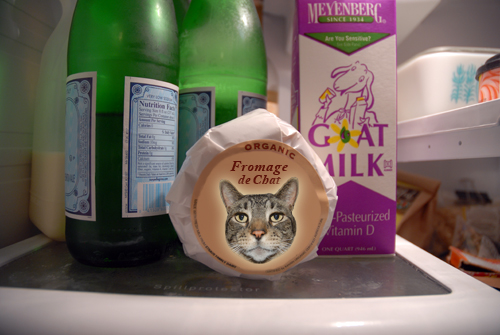
Last week I was introduced to something I didn't even know existed: cat cheese. Known to cheese mongers as Fromage de Chat (or often just chat fromage), this cheese has become the new "it" food in the culinary world.
So what is cat cheese? As you may suspect, it's simply cheese made from the milk of a feline. According to Cheesemonger's Weblog, it's quite popular in Eastern Europe, which makes sense as the Siberian cat has particularly rich milk and there's really not a lot to eat in that part of the world. But cat cheese has been a staple in many cultures since the pharaohs began demanding it at their dinner tables thousands of years ago to honor Mafdet, the lion goddess. According to historical records, cats were first tamed by Egyptians to help control their diets and thus shape the milk's taste. Although some people seemed to enjoy the natural flavors of wild cat's milk, the pharaohs wanted their cheese to taste more like river fish than mongoose and rats, and so the domesticated cat was born.
Cat cheese is currently made mostly in small urban farms. Each city seems to have its own purveyor. In the Bay Area, Freyja Jones, a 70-year old woman who lives in Montclair, is the resident cat dairy woman. Living in an old hunting cabin near a local swimming and tennis club, Freyja has over 200 cats on her property. And while that may seem like a lot of animals to put in a 1500 square foot house, Freyja's operation is a smooth running machine and she says she wouldn't mind having millions of cats. At the moment, there are Siamese in the master bedroom, Angoras in the den, calicos in the living room, and then mixed breeds everywhere else. For a while, Freyja toyed with using hairless cats, but found their milk to be a bit anemic and so offered them up for adoption.
During my visit, I was honored to be included in the milking process. Freyja and her 40-year old daughter Dinah milk each cat by hand. For a while they used an invention by Dinah called The Pussy Milker, but decided it was more difficult to place the cats in a harness than it was to actually milk them in their laps, so gave up on it. While I looked on as Freya and Dinah laid cats on their laps for milking, Freyja looked up at me and yelled above the din of meowing "Don't forget to wear your gloves!" as a large Angora batted a paw full of sharp claws at her.
After trying a few varieties, I've found that cat cheese has many unique flavors. Siamese milk has an underlying sardine taste, which makes it perfect for using as the base in hard cheeses, while Angora milk has a more musky flavor best used for ash-covered cheeses. The standard house cat, however, produces the creamiest milk of all, which is then used to make a tangy mozzarella de gatto.